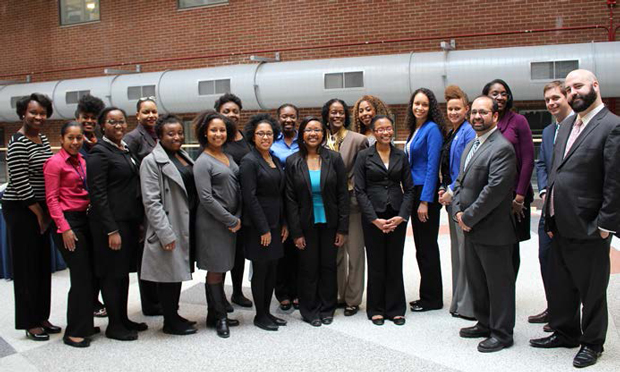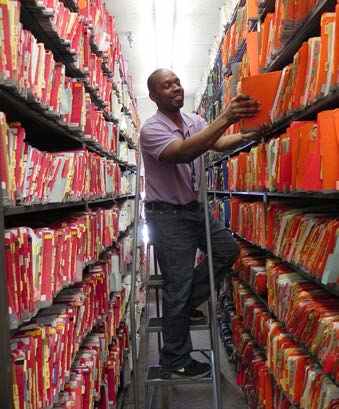

April 2015
IN THIS ISSUE:
![]()
- New therapy may prevent four viral infections after a stem cell transplant
- Managing medical supplies: A shortage of IV fluids has not impacted patient care at the Clinical Center
- Hundreds of local volunteers, including a pair of sisters, give time, skills and support to NIH
- Turning Trash to Treasure: 900 tons of waste recycled in 2014
- Spelman College students visit NIH, learn about science careers from alumni
- NIH-led study to assess community-based hepatitis C treatment in Washington, D.C.
- Keeping the records of Clinical Center medical history
- Fibromyalgia study seeks participants
- Upcoming Events
Print this Issue ![]() (455 KB)
(455 KB)
ABOUT CC NEWS:
![]()
Published monthly by the Office of Communications and Media Relations. News, article ideas, calendar events, letters, and photographs are welcome. Submissions may be edited.
Clinical Center News
National Institutes of Health
Building 10, 10 Center Drive
Room 6-2551,
Bethesda, MD 20892-1504
Tel: 301-594-5789
Fax: 301-402-0244
Molly.hooven@nih.gov
2015 ISSUES:
![]()
QUICK LINKS:
![]()
New therapy may prevent four viral infections after a stem cell transplant
 |
With protective masks covering their smiles, patient Leticia Gutierrez (front left), her brother, and medical team gather to document the novel infusion of multi-virus specific immune cells (T-cells) which could one day lead to eliminating the risk of certain viral infections post-stem cell transplant patients often acquire. |
On March 10, Leticia Gutierrez, a patient on 3NE who is undergoing stem cell transplantation, received a novel cell therapy treatment designed to fend off four viruses that commonly affect stem cell transplant recipients: Cytomegalovirus, Epstein-Barr virus, Adenovirus and BK-virus. She is the first of 10 partici-pants in a Phase 1 National Heart, Lung, and Blood Institute (NHLBI) clinical trial.
Viral infections affect about 80 percent of people who receive stem cell transplantation and can lead to prolonged hospitalization, serious complications or even death.
It is hoped the infusion of these multi-virus specific immune cells (T-cells) will make the post-transplant course of patients much smoother. To prepare the cell infusion, lymphocytes (a type of white blood cell with great importance to the immune system) are harvested from the blood of a transplant donor; in this case the donor was Leticia's brother. The cells are stimulated with virus antigens to generate improved lymphocytes that can recognize and eliminate the four viruses listed above. After two weeks in the lab, the cells were tested for safety and function. Then, the patient had an infusion to put the cells back into her body.
This new cell therapy strategy is pioneered by Dr. Pawel Muranski, Dr. Minoo Battiwalla and Dr. John Barrett from the NHLBI Hematology Branch. Manufacturing of the cells was supervised by Dr. David Stroncek, from the NIH Clinical Center Department of Transfusion Medicine.
In the future, the investigators plan to provide the multi-virus T-cell treatment closer to the date of the stem cell transplantation to minimize the patient's risk of developing viral diseases.
Researchers hope this innovation will lead to improved transplant outcomes and significantly reduce transplant costs. The research project leading to the successful production of multi-virus specific immune cells was funded by a Bench to Bedside award.
Managing medical supplies: A shortage of IV fluids has not impacted patient care at the Clinical Center
 Hospitals nationwide have been facing a shortage of medical supplies, specifically sterile intravenous (IV) fluids, and the Clinical Center is no exception. But through prudent planning, the Clinical Center has been able to ensure its patients have not been affected.
Hospitals nationwide have been facing a shortage of medical supplies, specifically sterile intravenous (IV) fluids, and the Clinical Center is no exception. But through prudent planning, the Clinical Center has been able to ensure its patients have not been affected.
Intravenous fluids are important because they are the fastest way to deliver fluids and medications throughout the body. IV fluids can be used to deliver medications, as fluid replacement to treat dehydration or to administer chemotherapy to patients with cancer. Different fluids have different clinical or pharmaceutical uses: a saline solution would be used to clear an IV line following blood product administration; a dextrose solution would be used to help maintain adequate glucose levels and certain medications can only be mixed with specific types of solutions.
Each year, the Clinical Center uses several million units of IV fluids in treating its patients.
Several factors have contributed to the ongoing shortage of IV fluids: high demand due to influenza and other infectious disease outbreaks; stockpiling of materials to prepare for emergency planning; changes in production processes by manufacturers and distributors that impact how IV fluids are allocated to hospitals and other users; and regulatory activity like recalls of medical supplies by manufacturers and the Food and Drug Administration.
Finding a Solution
In 2013, the Clinical Center's Materials Management and Environmental Services (MMES) Department noticed that it was becoming harder to buy sterile IV fluid. To understand the scope of the problem, a multi-disciplinary team composed of representatives from Clinical Center MMES, Nursing, Pharmacy and the Office of the Director was formed in early 2014. The team quickly came to understand how serious and widespread the problem was. Ultimately, 80 sterile IV fluids used by the Clinical Center were affected by the shortage.
Recognizing the severe impact this unavailability could have on patient care, the Clinical Center found external suppliers for IV fluids for human use to bolster the supplies.
Meanwhile, the Clinical Center changed how it managed medical supplies. IV fluids in critical short supply were removed from routine availability and the Pharmacy assumed responsibility for dispensing sterile IV fluids to most patient care locations.
To help reduce waste and prolong the life of supplies onsite, staff was also instructed to remove the IV fluid container from its protective overwrap packaging only at the time it was needed for infusion. Following the lead of other hospitals across the country, the Hospital Epidemiology Service increased the length of time sterile IV fluid could be used safely, prolonging the life of supplies while avoiding an impact on patient care.
Ensuring Supply
In response to potential shortages, the Clinical Center has moved from holding a month's supply of each sterile IV fluid to at least a two-month supply for 40 critical fluids. To support this policy the Clinical Center has changed its procurement strategy and has altered or added storage locations within the building for additional medical supplies.
Forty critical fluids are tracked weekly by the Clinical Center team and are compared with usage rates and historical data to help guide what materials are ordered. Research has uncovered quality substitutes for many IV fluids, which helped to expand medical supplies available to the hospital.
"While this is a complex issue to manage, our goal has been to avoid any impact on patient care," said Robert Mekelburg, chief of the Clinical Center's MMES Department. "Our top priority is ensuring that the Clinical Center always has the IV fluids it needs."
The team's successful management of the ongoing IV fluid shortage was recognized by Dr. John I. Gallin, director of the Clinical Center, at the 2014 Clinical Center Director's Award Ceremony.
Hundreds of local volunteers, including a pair of sisters, give time, skills and support to NIH
While the strength of the Clinical Center is based on thousands of individuals who volunteer to participate in clinical trials, there are often hundreds of other volunteers that are also crucial in delivering support to those participants, their families, visitors and staff.
Every April, the Clinical Center celebrates National Volunteer Week and the dedicated members of the Volunteer Program led by the Social Work Department. The program supports approximately 240 volunteers in any given year. Volunteers perform a wide variety of tasks in the Clinical Center, such as clinical support services, act as patient ambassadors and assist as language interpreters.
Two volunteers who have been invaluable to the Clinical Center are sisters Beatriz Ostria and Susana Otero.
"In my volunteer role, I work as an interpreter as well as listen to patients and try to comfort them," Ostria said. "I love to give my time and skills to people who need support."
Ostria started as a Clinical Center volunteer in 2009. While she is originally from Argentina, her family is also from Bolivia and France — she speaks French, Spanish and English. She brings a wealth of knowledge to the volunteer program from her 28-year career in language translations for the World Bank.
Ostria's sister, Otero, had always wanted to volunteer, but was not sure how she could fit in the time between a busy work and family life. Once Otero heard from her sister how rewarding the experience really is and how great the need is for language interpreters, she was determined to find time to volunteer. After more than two years, she remains glad with her decision to be a part of the Volunteer Program at the Clinical Center.
"I always admired the work of NIH," said Otero. "Their doctors and researchers are so highly qualified that their work is respected not only in the U.S., but in the world. Doctors and nurses at NIH treat patients with such care and respect that it is a pleasure to help them communicate with patients."
The Clinical Center looks forward to honoring Otero, Ostria and all of the other volunteers during National Volunteer Week, April 12-18.
Turning Trash to Treasure: 900 tons of waste recycled in 2014
While many of us tend to think of our impact on the environment on Earth Day, which falls on April 23 this year, the Clinical Center makes reducing waste a daily priority.
The Clinical Center has participated in a recycling program since 1996, and the program has grown over the years to include paper, cans, glass, certain plastics, toner cartridges, compost, animal bedding and scrap metal. Recycling bins are available throughout the hospital and compost bins for food waste are available in cafeterias.
Recycling is mandated, not only by Montgomery County regulations - where the NIH is located - but also by federal Executive Orders that encourage environmental management and performance. The Executive Orders require government agencies to "minimize generation of waste and pollutants" and "divert at least 50 percent of non-hazardous solid waste" from landfills to greener options.
The Clinical Center has embraced this challenge, recycling almost 912 tons of materials in 2014. All waste that is not recycled or composted is incinerated at a waste-to-energy facility, meaning little to no trash goes to the landfill from NIH.
Recycling at the NIH is administered by the NIH Environmental Management System (NEMS) run by the Office of Research Facilities and supported by the Clinical Center's Green Team.
Take a look at the article below to view common items that can be recycled. In addition to paper products, commingled materials and food waste, you may also recycle toner cartridges, pipette tips and certain animal bedding products.
Toner cartridges can be placed in "Toner/Ink Jet Cartridge" bins. Printer and copier toner cartridges are transported to Virginia where they are sorted, boxed and distributed for remanufacturing. For every usable cartridge that is recycled, a $1 donation is made to an NIH charity: the Children's Inn at NIH, Special Love for Children with Cancer - Camp Fantastic or the Friends of the Clinical Center.
Pipette tip racks can be placed in "Pipette" recycling bins. Recycled pipettes are sent to a processor to be melted into black pellets which are made into flower pots.
Uncontaminated animal bedding comprised of pine shavings, corn cob, hardwood, wood pulp from plants, bedding bags and animal feed is also composted. The food and animal bedding is shipped off-site and goes through a composting process where microbes decompose and generate heat which eliminates pathogens. The end product is nutrient rich and is used in farming, landscaping and gardening.
NEMS estimates that each person at NIH disposes of 2.4 pounds of trash per day while recycling 1.7 pounds of materials. With a little effort, we can all make sure we get the appropriate waste in the recycling bin instead of the trash can.
When you drop an item in the recycling bin, what happens next?
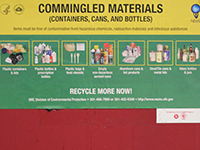 | Empty aluminum cans, foil, all plastic bottles & containers with the numbers 1, 2, 3, 4, 5, 6 or 7 labeled on them (often in a triangle shape, which looks very similar to the recycling symbol), yogurt containers, steel and tins cans, glass bottles and jars, prescription bottles, food storage bags, storage containers, plastic utensils and plastic bags. Metal is sorted and sent to Montgomery Scrap where it is shipped to be melted and made into new products. Plastic is shipped to a carpet mill to be made into new carpet. Glass is sent to the Montgomery County Transfer Station for recycling with other homeowner waste. | |
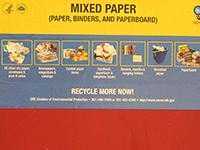 | Newspaper, magazines, scientific journals, catalogs, binders, Post-It notes, manila folders, envelopes, white or colored paper, frozen food boxes, all paperboard, cardboard and tissue and paper towel boxes – but not the tissues or towels themselves. The recycled paper is eventually processed into paper towels and toilet paper while cardboard is used to make new fiberboard for boxed items like pizza, candy and DVDs. | |
 | Food waste can be placed in bins in the B1 and second floor cafeterias in the Clinical Center. Composting is limited to leftover food, paper products (such as napkins, containers, shells, trays and cups without lids) and other compostable items like Greenware products. | |
Five Things You Can Do to Keep the Clinical Center Green 1. Get a blue recycling bin for your workspace. The Clinical Center's Green Team distributed over 700 desk-side recycling bins to help increase recycling rates. Do you need a set of desk-side bins? 2. Think before you print. NIH recycled 660 tons of paper in 2014, the equivalent of 16,500 sheets of paper per employee. You can help reduce this substantial number by printing less, printing double-sided or not printing at all; emailing, scanning and/or signing documents electronically; and reusing paper, envelopes and file folders. 3. Make sure chemical waste is disposed of properly. Chemical waste should be properly labelled and stored in the lab while waiting for pick up. Do not store chemical waste in public areas or pour it down the drain. Learn more. 4. Drop your printer or toner cartridge in the dedicated recycling bin. These cartridges can be reused and NIH charities receive $1 for each cartridge that is recycled. 5. Check out the latest developments online. Look at the Clinical Center's Green Team webpage at or check out the NIH Environmental Management System. |
Spelman College students visit NIH, learn about science careers from alumni
Students from Spelman College spent their last day of spring break, March 13, at NIH learning more about opportunities to advance their science and health academic interests. The event was hosted at the Clinical Center in the Foundation for Advanced Education in the Sciences classrooms. Eight students and two advisors from the college's Health Career Program participated in a day filled with presentations, campus tours and panel sessions. Students met with NIH training program administrators and human resources professionals. After a networking lunch with staff, the students toured the National Library of Medicine to learn about bioinformatics and computational biology. The day concluded with a special career panel of Spelman College alumni. |
NIH-led study to assess community-based hepatitis C treatment in Washington, D.C.
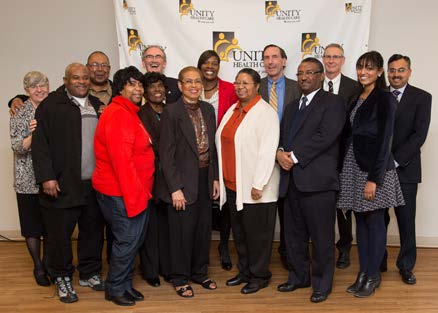 |
NIH officials, Dr. Henry Masur, (fifth from the right) and Dr. Carl Dieffenbach (third from the right), join D.C. government officials, healthcare representatives and patients in kicking off the hepatitis C study. |
On March 4, officials from the NIH and the city of Washington, D.C., came together in the district to launch a new clinical trial. The trial will examine whether primary care physicians and other health care providers, such as nurse practitioners and physician assistants, can use a new antiviral therapy as effectively as specialist physicians to treat people with hepatitis C virus (HCV) infection.
The trial, which will involve 600 adult D.C. residents infected with HCV alone or co-infected with HCV and HIV, also will examine the long-term effects of the treatment. Patients will be treated at clinics operated by Unity Health Care, Inc. and Family and Medical Counseling Services. Both organizations are active collaborators in the D.C. Partnership for HIV/AIDS Progress, a program that aims to reduce the burden of HIV/AIDS and associated diseases, such as hepatitis C, in the District.
The Study to Assess Community-based Treatment of Chronic Hepatitis C Monoinfection and Coinfection with HIV in the District of Columbia, called ASCEND, is co-sponsored by the NIH's Clinical Center and National Institute of Allergy and Infectious Diseases, with additional support from the NIH Office of AIDS Research.
In 2014, a new, once-daily antiviral drug was approved for treatment of HCV infection. Gilead Sciences, the drug manufacturer, is providing it free-of-charge for use in this study.
"This study demonstrates the benefit that research can have on the community," said Dr. Henry Masur, principal investigator on the study and chief of the NIH Clinical Center's Critical Care Medicine Department. "NIH, community clinics and the D.C. Department of Health are working collaboratively to reduce the impact of a lethal viral disease, hepatitis C, on the population of our nation's capital."
Keeping the records of Clinical Center medical history
The Medical Record Department celebrated Heath Information Professionals week in March. The depart-ment held a celebratory breakfast for staff to gather and focus on all that's been accomplished. The department plays a critical role in the delivery of quality care at the Clinical Center. More importantly, the week provided an opportunity for staff to attend educational sessions to stay up-to-date on the continued responsibilities which includes ensuring medical records are accurately documented in a timely manner, readily accessible and permit prompt retrieval of data. Comprised of 37 employees, the department provides a central connection between medical providers, patients, and outside entities. |
Fibromyalgia study seeks participants
The National Center for Complementary and Integrative Health is looking for people with fibromyalgia to participate in an MRI study exploring how the brain responds to pain. The study requires outpatient visits at the Clinical Center. Compensation will be provided. Call 301-594-5731 (TTY 1-866-411-1010) or visit www.clinicaltrials.gov. Refer to study #13-AT-0143.
Upcoming Events
Most lectures will be streamed live and archived
Clinical Center Grand Rounds Lecture
Updates in Diagnosis of Prostate Carcinoma
April 22, 2015, Noon – 1:00 p.m.
Lipsett Amphitheater
Presented by Peter Choyke, MD, NCI and Peter Pinto, MD, NCI.
19th Annual Take Your Child to Work Day
April 23, 2015, 9:00 a.m. – 4:00 p.m.
Front lawn of Building 1
Employees may bring their daughters and sons to campus to learn about the important work done at NIH and to explore occupations that support the public health services. Take Your Child to Work Day at NIH may allow children to make the connection between what they're learning in school today and the impact it can have on their future.
NIH Earth Day - "It's Our Turn to Lead"
April 23, 2015, 10:00 a.m. – 2:00 p.m.
Front lawn of Building 1
Activities and information will be available for NIH employees, contractors, visitors and children on campus for Take Your Child to Work Day. NIH employees at offsite are encouraged to take advantage of extra shuttles that will run on Earth Day.
Clinical Center Grand Rounds Lecture
Using Biological Factors to Direct Therapy in Diffuse Large B-Cell Lymphoma
April 29, 2015, Noon – 1:00 p.m.
Lipsett Amphitheater
Presented by Louis M. Staudt, MD, NCI and Kieron Dunleavy, MD, NCI.
2014-2015 NIH Medical Research Scholars Program Scientific Presentations
May 11 - 12, 2015, 9:00 a.m. – 3:30 p.m.
FAES Classrooms – Oral Presentation; FAES Terrace – Poster Session
Forty-two students who have engaged in a mentored basic, clinical, or translational research project at NIH will present their medical research. Staff are encouraged to support the next generation of clinician-scientists.
Stephen E. Straus Distinguished Lecture in the Science of Complementary Health Therapies
When Experts Disagree: The Art of Medical Decision Making
May 11, 2015, Noon – 1:00 p.m.
Masur Auditorium
Presented by Jerome Groopman, MD, Harvard Medical School and Pamela Hartzband, MD, Harvard Medical School.
NOTE: PDF documents require the free Adobe Reader.
 The information on this page is archived and provided for reference purposes only.
The information on this page is archived and provided for reference purposes only.